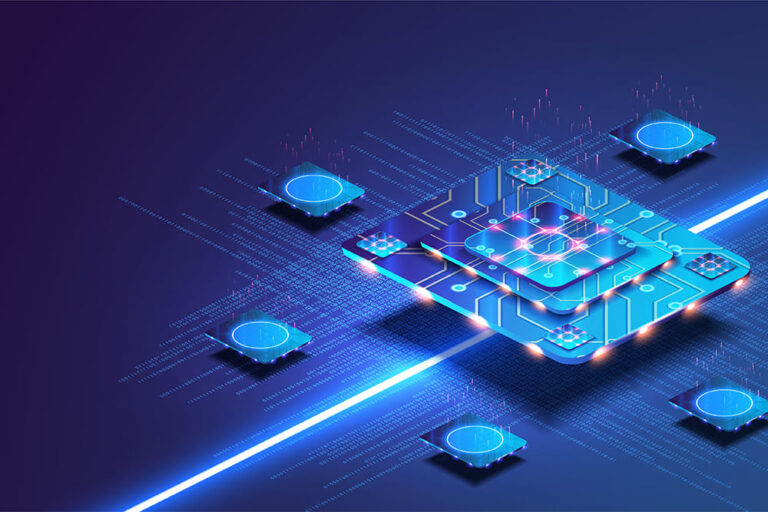The Quantum Computing Revolution

At its core, quantum computing leverages the principles of quantum mechanics—the physics that governs the behavior of matter and energy at the atomic and subatomic levels—to perform calculations. Unlike classical computers that store information as bits, which can only be 0 or 1, quantum computers use qubits.
A. Qubits and Superposition: The fundamental building blocks of quantum computers are qubits. What makes them revolutionary is their ability to exist in a superposition of states, meaning a qubit can be 0, 1, or both simultaneously. This contrasts sharply with classical bits, which must be in a definite state of either 0 or 1. This “both at once” property allows quantum computers to process and store exponentially more information than classical computers using the same number of bits. As the number of qubits increases, the computational power grows exponentially, not linearly, offering a dramatic leap in processing capability.
B. Quantum Entanglement: Another mind-bending quantum phenomenon is entanglement. When two or more qubits become entangled, they become interconnected in such a way that the state of one instantly influences the state of the others, regardless of the distance separating them. This interconnectedness is a powerful resource, allowing quantum computers to perform highly parallel computations and create complex relationships between data points, which is impossible with classical bits. Entanglement enables quantum algorithms to explore multiple possibilities simultaneously, drastically speeding up certain types of calculations.
C. Quantum Interference: Just like waves of light or sound, quantum states can interfere with each other. In quantum computing, this property is harnessed to amplify the correct answers and cancel out the incorrect ones. By carefully controlling the interference patterns, quantum algorithms can guide the computation towards the desired solution, making them incredibly efficient for specific problems. This ability to manipulate probabilities is key to quantum algorithms’ power.
D. Quantum Gates and Circuits: Similar to logic gates in classical computing, quantum gates are the elementary operations that manipulate the states of qubits. These gates are unitary transformations that operate on one or more qubits, performing operations like rotations, phase shifts, and entanglement. By stringing together a sequence of quantum gates, researchers design quantum circuits to execute specific algorithms. The design and optimization of these circuits are critical to harnessing the full power of quantum computers for different applications.
Quantum Computing’s Transformative Impact Across Industries
The practical implications of quantum computing are far-reaching, promising to disrupt and redefine numerous industries by solving problems that are currently beyond the reach of even the most powerful supercomputers.
1. Healthcare and Pharmaceuticals
Quantum computing holds immense promise for revolutionizing healthcare and drug discovery, leading to more effective treatments and personalized medicine.
A. Drug Discovery and Development: Designing new drugs is an incredibly complex and time-consuming process. Quantum computers can simulate molecular interactions with unprecedented accuracy. This means researchers can model how different drug compounds will interact with proteins and other biological targets at an atomic level, vastly accelerating the identification of promising drug candidates, predicting their efficacy, and understanding potential side effects. This could lead to a significant reduction in the time and cost associated with bringing new medications to market.
B. Personalized Medicine: Quantum algorithms can analyze vast datasets of genetic information, patient histories, and treatment responses to identify highly personalized treatment strategies. By understanding individual genomic variations and disease progression at a fundamental level, quantum computing could enable the creation of bespoke therapies tailored to each patient’s unique biological makeup, leading to more effective and targeted treatments with fewer adverse reactions.
C. Protein Folding Simulation: Understanding how proteins fold into their complex 3D structures is crucial for understanding diseases and designing new drugs. Protein folding is an incredibly complex computational problem with an astronomical number of possible configurations. Quantum computers are uniquely suited to tackling this, potentially unraveling the mysteries of misfolded proteins in diseases like Alzheimer’s and Parkinson’s, and paving the way for new therapeutic interventions.
D. Advanced Medical Imaging: Quantum sensors and computing could lead to ultra-sensitive medical imaging techniques, allowing for earlier and more precise detection of diseases. For instance, quantum MRI could provide higher resolution images with shorter scan times, revealing subtle abnormalities previously undetectable, which can lead to earlier diagnosis and intervention.
2. Finance
The financial sector, with its reliance on complex calculations and data security, is a prime candidate for quantum disruption.
A. Financial Modeling and Risk Analysis: Quantum computers can run highly complex financial models with many variables much faster than classical computers. This allows financial institutions to perform more sophisticated risk analysis, optimize investment portfolios, and predict market fluctuations with greater accuracy. They can analyze interconnected risks across global markets, leading to more robust financial strategies and better resilience against economic shocks.
B. Fraud Detection and Cybersecurity: While quantum computers pose a long-term threat to current encryption methods (see Quantum Cryptography below), they can also enhance cybersecurity in the short to medium term. Quantum algorithms can analyze vast amounts of transactional data to detect subtle patterns indicative of fraud, even in real-time, far more effectively than classical systems. Furthermore, they can strengthen existing cryptographic protocols and develop new quantum-resistant ones to safeguard sensitive financial data against future quantum attacks.
C. Arbitrage Opportunities: Quantum algorithms might be able to identify fleeting arbitrage opportunities in financial markets by processing and analyzing market data at speeds currently unattainable. This could give quantum-enabled traders a significant advantage, although it would also lead to increased market efficiency and potentially reduce the longevity of such opportunities.
D. Derivatives Pricing and Portfolio Optimization: The complex calculations involved in pricing derivatives and optimizing large investment portfolios, considering various constraints and market conditions, are well-suited for quantum acceleration. Quantum algorithms could enable real-time re-optimization of portfolios and more accurate valuation of complex financial instruments, leading to better returns and reduced risk.
3. Materials Science
Quantum computing is poised to revolutionize the design and discovery of new materials with desired properties, from superconductors to more efficient batteries.
A. New Material Discovery: Understanding and predicting the properties of materials at the quantum level is computationally intensive. Quantum computers can simulate molecular and atomic interactions with unprecedented precision, enabling the design of novel materials with specific characteristics. This could lead to the discovery of room-temperature superconductors, more efficient catalysts for industrial processes, or materials with enhanced strength-to-weight ratios for aerospace applications.
B. Battery and Energy Storage: Developing next-generation batteries with higher energy density, faster charging times, and longer lifespans is critical for electric vehicles and renewable energy storage. Quantum simulations can help design new electrolyte materials and electrode structures at the atomic level, leading to breakthroughs in battery technology that are currently out of reach.
C. Catalyst Optimization: Catalysts are crucial for many industrial chemical processes, making them more efficient and environmentally friendly. Quantum computing can simulate the complex chemical reactions involved in catalysis, leading to the design of more effective and selective catalysts that reduce energy consumption and waste in industries like agriculture and chemical manufacturing.
D. Drug Delivery Systems: Beyond drug discovery, quantum computing could aid in designing advanced drug delivery systems. By precisely simulating how nanoparticles interact with biological systems, researchers could develop targeted drug delivery methods that reduce side effects and increase therapeutic efficacy, delivering medicine directly to diseased cells.
4. Artificial Intelligence (AI) and Machine Learning (ML)
The synergy between quantum computing and artificial intelligence is profound, promising to unlock new levels of intelligence and problem-solving capabilities.
A. Quantum Machine Learning (QML): This emerging field combines the power of quantum computing with machine learning algorithms. QML algorithms can process and analyze vast datasets more efficiently, potentially leading to faster training of AI models, improved pattern recognition, and the ability to find subtle correlations in data that classical ML struggles with. This could revolutionize areas like image recognition, natural language processing, and predictive analytics.
B. Optimization for AI Models: Training complex deep learning models involves solving massive optimization problems. Quantum annealing and other quantum optimization algorithms could significantly speed up the training process for AI, allowing for the creation of more sophisticated and accurate models in a fraction of the time. This could unlock advancements in areas like autonomous driving and personalized recommendation systems.
C. Enhanced Data Analysis: Quantum computers can analyze high-dimensional datasets with greater efficiency than classical computers, identifying complex patterns and anomalies. This is particularly useful for big data analytics, enabling more insightful predictions and decision-making across various applications, from consumer behavior analysis to scientific discovery.
D. Complex System Simulation for AI: Quantum computers can simulate complex systems with many interacting variables, which is a key component for developing more advanced and nuanced AI. For example, simulating brain activity or complex biological networks for neurological research could be significantly enhanced, leading to breakthroughs in understanding intelligence itself.
5. Cryptography and Cybersecurity
Quantum computing presents both a significant threat and a promising solution for cybersecurity, ushering in a new era of cryptographic challenges and opportunities.
A. Breaking Current Encryption (Shor’s Algorithm): One of the most well-known quantum algorithms, Shor’s algorithm, can efficiently factor large numbers. This poses a direct threat to widely used public-key encryption standards like RSA and ECC, which rely on the computational difficulty of factoring large numbers. Once sufficiently powerful quantum computers exist, they could potentially break much of the encryption that secures our online communications, financial transactions, and sensitive data. This is often referred to as the “Quantum Apocalypse” for current cryptography.
B. Quantum-Resistant Cryptography (Post-Quantum Cryptography – PQC): In response to the threat posed by Shor’s algorithm, intense research is underway to develop post-quantum cryptography (PQC). These are cryptographic algorithms designed to be secure against attacks by both classical and quantum computers. Governments and industries worldwide are actively working on migrating to these new standards to protect against future quantum threats. The transition to PQC is a massive undertaking, requiring significant investment and coordination.
C. Quantum Key Distribution (QKD): On the flip side, quantum mechanics also offers a fundamentally secure way to distribute cryptographic keys through Quantum Key Distribution (QKD). QKD uses the principles of quantum mechanics (like the no-cloning theorem) to detect any eavesdropping attempt on a communication channel. If an eavesdropper tries to intercept the key, the quantum state changes, immediately alerting the legitimate parties. This provides information-theoretic security, meaning its security is guaranteed by the laws of physics, not by computational complexity.
D. Enhanced Network Security: Beyond QKD, quantum computing could enable new paradigms for network security, such as quantum authentication and quantum secure multiparty computation, allowing multiple parties to compute a function on their private inputs without revealing those inputs to each other. This promises a future of vastly more secure digital interactions.
Challenges and the Road Ahead for Quantum Computing

Despite its immense promise, quantum computing is still in its nascent stages and faces significant technical, economic, and societal challenges that need to be addressed for its widespread adoption.
1. Hardware Development:
Building stable, scalable, and error-corrected quantum computers is incredibly difficult.
A. Qubit Stability and Decoherence: Qubits are extremely fragile and susceptible to decoherence, meaning they lose their quantum properties (superposition and entanglement) very quickly due to interactions with their environment (noise, temperature fluctuations). Maintaining qubit coherence for long enough to perform complex calculations is a major hurdle. This often requires extremely low temperatures (near absolute zero) and vacuum environments.
B. Error Correction: Quantum computations are prone to errors due to decoherence and environmental noise. Developing robust quantum error correction techniques is crucial to build fault-tolerant quantum computers. This requires an overhead of many physical qubits to encode one logical, error-corrected qubit, making large-scale quantum computers even more complex to build.
C. Scalability: Current quantum computers have a limited number of qubits (noisy intermediate-scale quantum, or NISQ, devices). Scaling up to thousands or millions of stable, interconnected qubits, which will be necessary for truly revolutionary applications, is a monumental engineering challenge. Researchers are exploring various qubit technologies (superconducting circuits, trapped ions, photonic qubits) but none has yet achieved full scalability.
D. Interconnectivity: Connecting qubits in a way that allows for complex quantum operations across a large number of qubits without introducing excessive errors is another significant hardware challenge. The architecture of quantum processors is as critical as the number of qubits.
2. Software and Algorithms:
Developing quantum software and algorithms is a specialized and evolving field.
A. Algorithm Development: Identifying and developing practical quantum algorithms that offer a significant speedup over classical algorithms for real-world problems is an ongoing area of research. Not all problems benefit from quantum computing, and finding the “quantum advantage” for specific applications requires deep theoretical understanding.
B. Programming Languages and Tools: The development of user-friendly quantum programming languages, compilers, and debugging tools is essential to make quantum computing more accessible to a wider range of developers and researchers. While frameworks like Qiskit (IBM) and Cirq (Google) exist, they are still relatively nascent compared to classical software development ecosystems.
C. Quantum Simulation: Simulating quantum systems on classical computers is incredibly resource-intensive. Developing efficient quantum simulators that can run on current and near-term quantum hardware is crucial for testing and optimizing quantum algorithms before full fault-tolerant machines are available.
3. Talent Gap:
There is a severe shortage of skilled professionals who understand both quantum mechanics and computer science.
A. Specialized Expertise: The intersection of quantum physics, mathematics, and computer science requires a unique skillset. Training a sufficient number of quantum engineers, programmers, and researchers is critical for the field’s growth. Universities and industry leaders are investing in quantum education programs, but the demand far outstrips the supply.
B. Interdisciplinary Collaboration: Breakthroughs in quantum computing often require collaboration between physicists, computer scientists, material scientists, and application-specific domain experts. Fostering such interdisciplinary teams is essential for translating theoretical quantum advantages into practical solutions.
4. Cost and Accessibility:
Quantum computers are extremely expensive to build and operate, limiting their accessibility.
A. High Research and Development Costs: The immense R&D investment required for quantum hardware and software development means that quantum computing is currently accessible primarily to large corporations, governments, and well-funded research institutions.
B. Infrastructure Requirements: The specialized environmental conditions (e.g., cryogenic temperatures for superconducting qubits) make operating quantum computers costly and complex, requiring dedicated infrastructure and expert technicians.
C. Cloud-Based Access: Cloud platforms (like IBM Quantum Experience, Amazon Braket, Microsoft Azure Quantum) are making quantum hardware more accessible, but resource allocation and usage costs can still be a barrier for smaller entities or independent researchers.
Conclusion
Quantum computing is not just an incremental step forward in computational power; it represents a paradigm shift that will fundamentally redefine the boundaries of what is computationally possible. While still in its early stages, the rapid pace of innovation suggests that quantum technologies will transition from niche applications to widespread industrial impact sooner than many anticipate.
The industries poised for the most profound disruption—from healthcare and finance to materials science and cybersecurity—are already investing heavily in quantum research and development. The ability of quantum computers to tackle problems intractable for even the most powerful supercomputers opens doors to scientific breakthroughs, unprecedented efficiencies, and entirely new products and services.
However, the journey to a quantum-enabled future is fraught with challenges, particularly in hardware scalability, error correction, and the development of quantum-specific algorithms and skilled talent. Addressing these hurdles will require sustained global investment, collaborative research, and a commitment to fostering a new generation of quantum-literate professionals.
As we stand on the precipice of the quantum era, the imperative is clear: embrace the potential, invest in the research, and proactively prepare for a future where quantum computers reshape industries and redefine the very limits of human ingenuity. The quantum leap isn’t just coming; it’s already beginning to transform our world.




